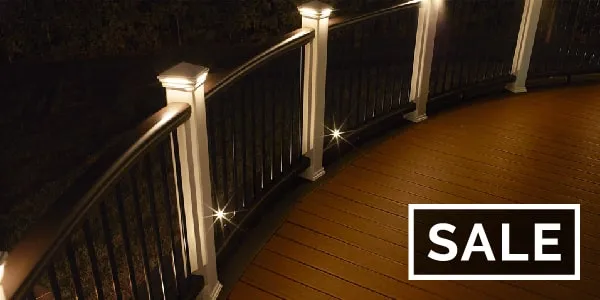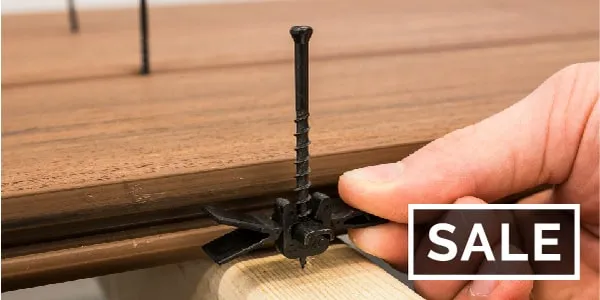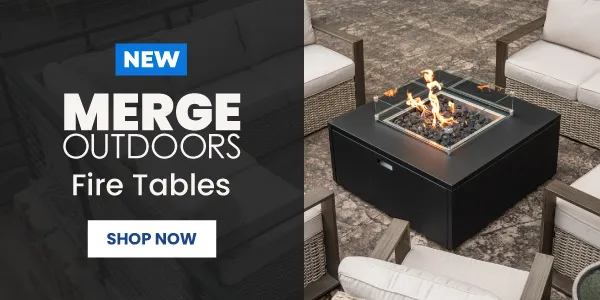Deck Lighting Troubleshooting
Installing a lighting setup for your outdoor area can be an electrifying way to bring your deck to life and help keep family and friends from trips and bumps in the night. However, over time, lighting systems can develop issues or require some maintenance. Most of these issues are common and straightforward to troubleshoot, with no electrician required. Are your low voltage lights not working? Solar lights stopped working like they should? Check out our Deck Lighting FAQs below to find your outdoor deck lighting solution, or give us a call at 1-888-824-5316 to speak with one of our deck experts.
Jump to a Question
- What size post cap light do I need?
- How do I get the wire from under the deck to the top of a wood post?
- Can I use both incandescent and LED lights on the same transformer?
- How many low voltage lights can I install on a transformer?
- I already have low voltage landscape lighting – can I add deck lighting to this?
- Should I bury my low voltage wire?
- Can I use two transformers in one series of lights?
- What is a multi-tap transformer?
- All of my lights won’t light up
- Some of my lights won’t light up
- My lights are blinking
- Some of my lights appear dimmer than others
- Can the brightness be reduced on low voltage lights?
- Can I wire decking lights to a switch?
- Do LED lights attract more bugs than incandescent lights?
- Solar Lighting Issues
- Can I charge my solar lights without the sun?
- Will my solar lights work in the winter?
- Can solar lights get wet?
- Do solar lights attract more bugs?
Low Voltage Deck Lighting Troubleshooting
What size post cap light do I need?
Post cap lights are listed on DecksDirect by their opening size. To determine the opening size you will need, simply measure the outside dimensions of your post and choose the opening size that closest matches those dimensions.
Note: Your opening size should be slightly about 1/16 inch to1/8 inch larger than your post to allow it to snugly sit atop your post. For example, if your post measures 5 inches by 5 inch, then you will want an opening size of 5-1/16 inch.
How do I get the wire from under the deck to the top of a wood post?
Option 1: Drill a ½ inch hole from under the deck out through the face of the post. Drill a core in the top of the post, following the instructions found in this lighting guide for Post Cap Installation. From below the bottom of the post pocket depth, drill a ½ inch hole at an angle up to the pocket. Thread the wire through the hole and out the face of the post. Run the wire along the face of the post and thread back into post pocket. Remove any twists in the wire and staple to the face of the post with stainless steel staples. Cover wire with matching trim.
Option 2: Use post sleeves to cover your post and wires.
Option 3: Cut or route a channel into the post. Once the wire is installed, cover with a batten strip or cut a filler piece to match the slot size and material. Secure with marine grade adhesive and sand smooth.
Option 4: Drill a ½ inch hole continuously through the post from the top to bottom. This is fairly difficult to do and typically requires expensive drill bits or bit extensions. Be careful to say in the center, and don’t let the drill bit bend off and out the side of the post.
How many low voltage lights can I install on a transformer?
Manufacturers generally recommend not installing more than 50 lights on a transformer.
Also, keep in mind your total wattage when figuring out how many lights your transformer can power. To do this, add together the total wattage for all of your light fixtures, then include an additional 10% wattage to allow for cables and connections that require energy as well.
Total Wattage of Lights x 1.1 = Transformer Size.
Can I use both incandescent and LED lights on the same transformer?
Yes, but we don’t recommend it. Mixing these bulb types may decrease the overall life of your LED lights and void your manufacturer’s warranty. It can still be done as long as the power type (AC or DC) and voltage level (12v) are the same.
I already have low voltage landscape lighting – can I add deck lighting to this?
As long as the lights you are adding are the same power type (AC or DC), voltage level (12v), and there is enough wattage capacity on your existing transformer; a new line of lighting can be added. We do not recommend tapping into existing landscape lighting lines. Most landscape lights use incandescent bulbs with an AC transformer. We don’t recommend adding LED lighting to an AC transformer.
Should I bury my low voltage wire?
You certainly do not have to bury your low voltage wire, and in fact, we recommend stapling or attaching your wire up into the frame of your deck to keep safe. Nylon Cable Ties make attaching low voltage wire under your deck simple.
If you do wish to bury your wire, we recommend going no deeper than 6 inches under the soil.
Can I use two transformers in one series of lights?
No, we do not recommend using two transformers in one system of lighting. You may get a larger transformer and split the load using a different wiring layout (refer to Wiring Layout section of the guide), or create two separate runs of lights using the two transformers respectively.
What is a multi-tap transformer?
A multi-tap transformer is designed to handle more than one lighting system at a time. By installing your deck lighting with a multi-tap transformer, you can easily add more lighting systems in the future without having to buy and install another transformer. One major benefit is a reduction in light dimming and premature bulb burnout.
To determine the size needed, add the combined wattages of the lighting that will be attached to the transformer, then divide the number by .08. For example: 220 total wattage / .08 = 275 Multi-tap transformer size: 300 watts.
All of my lights won’t light up:
- Make sure your transformer is fully plugged in and turned on.
- If a photocell is connected in your setup, make sure it isn’t detecting too much ambient light; ie. streetlights, house lights, etc. To test, cover the photocell with a piece of electrical tape and wait a few minutes for the transformer to warm up.
- Unplug your transformer and test the outlet with a different electronic device to make sure it’s functioning.
- Test the transformer, connect only one light directly to the transformer. If the light turns on, the transformer is working properly.
- Double check your wiring connections are secure and working with the correct polarity.
Some of my lights won’t light up:
- Check the polarity and security of your wire connections.
- Check to see if they work individually by checking each one alone with the transformer.
- If some lights just stop working suddenly, look at the wire/cable connecting to them. This could be a sign of a rodent chewing on the cords or a possible staple working its way through the wire.
My lights are blinking:
Blinking lights are a clear sign of a short somewhere within your wiring. Unplug your transformer right away, because if left plugged in this short can ultimately burn out your transformer. Check all of your wiring connections.
Some of my lights appear dimmer than others:
This is generally a wiring issue, often caused by using 200 feet or more wiring for one run of lights. A loop method of installation may solve the problem. Please refer to the Wiring Layout section of this guide. You can also use a voltage meter to check the fixtures at the end of each lighting row; the voltage should be between 10-½ and 11-½ volts.
Can the brightness be reduced on low voltage lights?
If you are working incandescent lights, then you may replace the bulb with a lower wattage version. The majority of AC transformers are not dimmer compatible.
If you are working with LED lights, then you may install a dimmer or dimmer switch to reduce the light output.
Can I wire decking lights to a switch?
Yes, there are two methods:
- Connect your transformer to an outlet that is already wired to a switch. This allows you to avoid having to hardwire your transformer directly to your house’s electrical system. If you do not have an outlet connected to a switch, please consult a local electrician.
- Install a wireless dimmer kit, such as this one by Dekor. After installing the compatible Dekor dimmer, this wireless receiver can send signals to the dimmer up to 150 feet away via the switch.
Do LED lights attract more bugs than incandescent lights?
No, incandescent lights produce heat and become warm as they glow. This heat is more attractive to bugs such as mosquitos and gnats.
Solar Deck Lighting Troubleshooting
Solar Lighting Issues
Make sure that the plastic tab has been removed from the battery compartment inside the solar post cap. This will block the battery from connecting with the terminal and powering the light.
Test your solar lights by replacing the rechargeable solar batteries with standard AA alkaline batteries and then completely covering the solar collector to test the unit. Do not keep the alkaline batteries in the fixture permanently as it can damage the light and void your warranty.
Check to ensure that your solar light is receiving enough bright sunlight throughout the day. This can affect the brightness and run time of your solar lights. Cloudy, overcast days and different seasons may also affect performance.
Allow your solar battery to fully charge. It can take new solar units up to three days of direct sunlight to cycle through to full capacity.
If you have tested your lights, and given your solar batteries enough time to charge in full sunlight; you may need to replace your solar rechargeable batteries.
Can I charge my solar lights without the sun?
Yes, you can charge them with either an incandescent or LED light. Solar cells will respond to the light in essentially the same way as sunlight, as long as it is bright enough.
Will my solar lights work in the winter?
Yes, solar lights will continue to work year round. Winter may, however, affect how well your light will perform. Shorter days and overcast weather can lead to shorter run times and a lower level of brightness.
Can solar lights get wet?
Yes, solar lights are weatherproof and can hold up to average rainfall. If you experience extremely cold or wet weather, we recommend storing them inside throughout the winter.
Do solar lights attract more bugs?
No, solar lights actually attract fewer bugs due to the fact that they produce no heat and are typically a cooler white color.
Are you sure you would like to remove this item from the shopping cart?
This item is a part of the approved quote. Removing it will remove all quote items from the cart.






